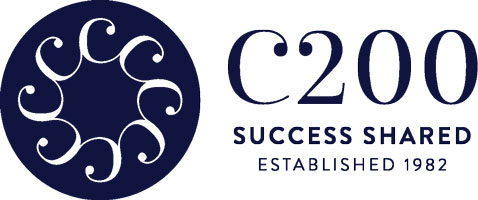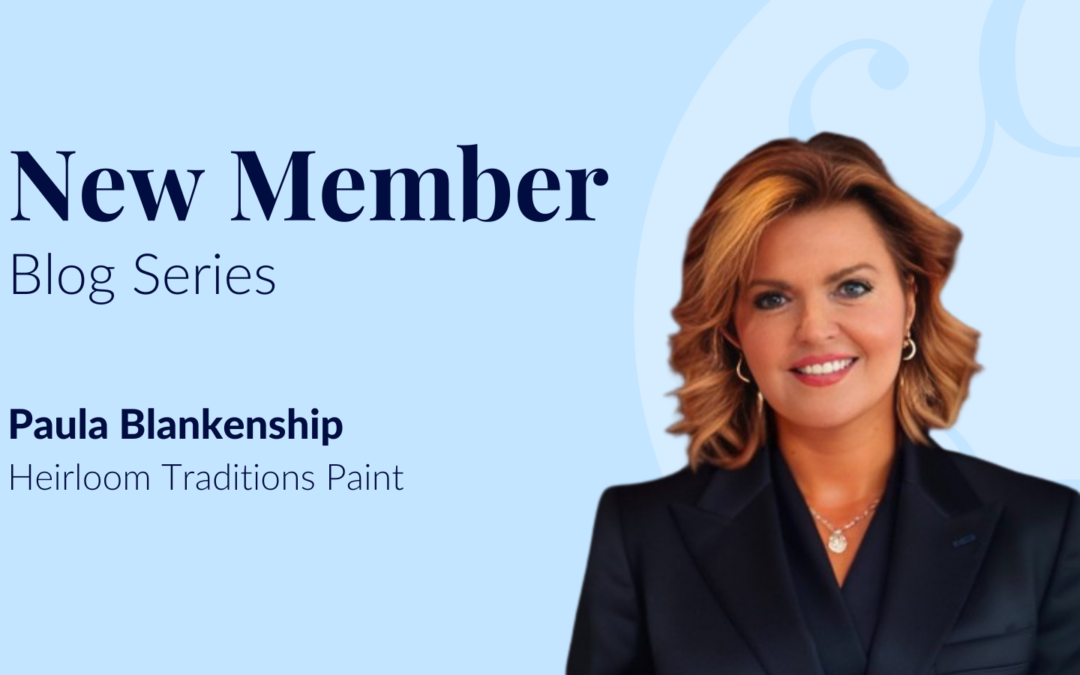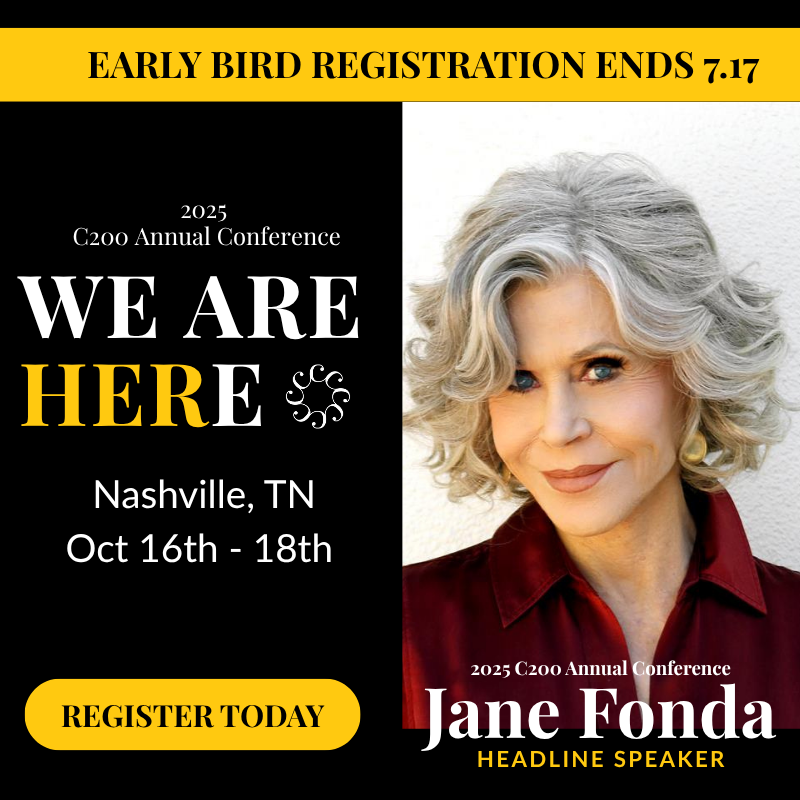Paula Blankenship is Founder & CEO of Heirlooms Traditions Paint, a business she started in 2013 to help educate her teenage son about the value and importance of entrepreneurship. Paula comes from a long line of entrepreneurial women, her mother, grandmother, and great-grandmother all having owned respective businesses. Paula believes the taking off and success of her company stems from her risk-taking strategy and utilization of social media to engage directly with customers. Outside of work, Paula enjoys painting in her studio and being a grandmother to her 1-year-old grandson and six step grandchildren. Paula has been a member of C200 since January 2024.
Eva Glassman: Tell me about how you founded your business. How did you get into the industry? How were you able to grow it, and what is your day-to-day like now?
Paula Blankenship: Before my current business, I had ran and owned various furniture and floor covering stores, and I was also a commercial interior designer. My entrepreneurial sensibilities come from a long line of women in my family; my mother owned a furniture store, my grandmother a farm and restaurant, and my great-grandmother a hotel.
My passion for DIY in particular, however, comes from my mother; rather than buying new furniture for her own home, she would paint what she already had in the warehouses. Painting was a source of therapy and relaxation for her. She was a wonderful entrepreneur; she had her hands in everything, from building homes to running the store. She always knew how to take something broken and repair it beautifully—and here I am in my own life now doing the same!
I started my paint business in my kitchen when I was fifty, a single mother raising my son, Braden, who was a teenager at the time. We had just moved to Louisville, Kentucky and my son didn’t have a great network of friends just yet, so I thought this new business venture would give him something to do and teach him about the importance of entrepreneurship.
I had no desire to turn my business into anything large; I was busy enough travelling around the region as a commercial interior designer. I started selling my paint product on eBay with a goal of selling $100 per day. My original plan was to sell color cards and start a business taking customers’ knockdown furniture and painting it, but when I posted the color cards on my Facebook Page, someone asked if they could buy the paint. I said yes—and wondered how I was going to create a paint line! One thing led to another, and I had all kinds of people on eBay asking if they could become a retailer for my paints. That helped me start the paint business and catapult my furniture business at the same time. I had about 300 retailers in less than a year; people loved the paint!
As we continued to grow, I saw an opportunity to do something unique and different. We grew another side of the business with online seminars showing people how to use the paint and what it really looks like. I had always been a retailer sitting in front of a door, waiting on customers to walk into my store—sitting and waiting. However, it’s a different world with the Internet because we can so easily share things. I would just take a photo and share it, and suddenly, people all over the country are interested in my products.
I encountered a couple of roadblocks with this strategy, however. Firstly, it was harder than I anticipated trying to educate the mom-and-pop retailers who stocked my product on how to utilize social media. Secondly, it started getting to the point where the inability for us to sell direct to the consumer began to limit our reach and scope. For those reasons, and especially because small retailers were closing more than opening across the country, I had to make a difficult choice to shift from B2B to B2C. It was a huge risk, but we were headed down an unsustainable path, so we had to pivot.
To make it work, we leaned even harder into social media and Facebook. We learned how to create and run digital ads, and I created lots of video content demonstrating how to use our paints. It was extremely DIY—I was making videos on my phone with iMovie! Everything was organic, but it paid off; we did $4.5 million in sales in just a short period of time, and that was four times over revenues we’d never seen before. The following year, we hit $10 million.
The reversal of that “retailer watching the front door and waiting for customers” mindset was key. Instead of waiting for the customer, we went to them with Facebook video content, and eventually, I couldn’t answer people quick enough.
EG: That’s amazing how vital a role social media has played in the growth of your business.
PB: We couldn’t have done any of it without the Internet. The wonderful thing about social media is that it’s so easy to find out more about brands that advertise online. It’s our biggest opportunity for customers to get to know us and trust us over big box brands. People value brands that feel authentic and real. In this environment, with everyone having a phone and a voice, if we did not deliver as a business, we wouldn’t have a brand.
EG: What else have you been able to do as a result of that growth and success? What are things like now?
PB: A couple of years ago, we decided to turn our business into an ESOP; the business is now 49% employee-owned. That’s been such a blessing to us all because a lot of these people understand what it is to build a business, and they’re excited to help us continue to build. Whether we change hands, sell, or change ownership, they’ll be rewarded for it, and it doesn’t cost them anything. I’m a huge advocate for ESOPs; it’s empowering to know the true ins and outs of the business as an employer and have that be completely transparent—especially if you’re a woman, because most of us don’t know those things. People need to understand the business, so I think ESOPs are a great platform to help people, especially entrepreneurial women, learn in a hands-on way.
We now run out of two buildings—one in Taylorsville and one in Louisville. The company recently reached woman-owned status when I bought the Louisville manufacturer that produced our paint products. That, in addition to now having three chemists on staff, has opened the doors for us to expand our product line to include other kinds of paints.
It’s wonderful to see how many people use our paints, take up some DIY projects, save money, and make real transformations that improve the quality of their lives. I feel privileged to help so many people change the way they feel about their home and encourage them that all they have to do is pick up that paintbrush to make their world something they enjoy. It’s way more than paint for me. I get emotional when I talk about it because it’s something I never dreamed would happen, and now that I have this platform, I have to do something great with it.
EG: Where does C200 fit into your professional journey? How did you get involved with the organization, and what made you join?
PB: I was in a JPMorgan Chase call with several other businesswomen, and I was trying to find a professional women’s organization to join at the time. I was in one already, but I wanted more out of it, especially as a woman running a big business with lots of dollars at stake. The women I was on the call with strongly recommended I check out C200 for that reason.
As a female entrepreneur, the more successful you become, the fewer friends you have. Not because people don’t like you anymore, but because what I love to talk about for fun is probably really boring to women who aren’t in business! Once you get to a certain financial level in your business, the air gets pretty thin and lonely for women. I’d like to have a community of women who I can meet, travel, and socialize with, in addition to having opportunities to sit down, talk, and chat to see what they’re facing and how we can learn from each other professionally.
EG: When you were growing your business, who are the women you would turn to for advice? Who were your mentors?
PB: I had no mentors—one of my big mistakes. However, Martha Stewart is someone I’ve always admired. She’s an entrepreneur who came into her business at fifty, which resonates a lot with my own experience. I like that she never let her age define how she strategized with a brand. I’m a risk-taker as an entrepreneur, so I look to Martha Stewart as a great visionary for taking on big risks and making big decisions.
Something else I’ve learned from Martha Stewart’s story is that, when you grow your business, you really have to delegate to someone who can ride the journey with you and not leave to seek another job. It’s a huge amount of trust; you’re revealing a lot of your stuff to this person. I found that that’s been a big part of my business. Our current CFO, Melissa Osbourne, helps me in more ways than just that; she takes this business as personally as I do. She’s helped build our online communities and our digital empire, jumping in headfirst with me even when we didn’t know what to do. I value her insights because she’s the more reasoned of the two of us; before I take a risk, she’s there to call me back down a little bit.
Another person who is integral to the business for me is my husband. Even though I’m the CEO, he’s still right there with me as President and helps me make decisions. He’s not a risk-taker, either—so I’ve got two very important people by my side to keep us in line! [laughs] Even though I believe certain risks I decided to take along the way helped grow our business to what it is today, their partnership does help me have a balance of opinions when it comes to making decisions. We have a give and take that has really worked for us as a team and as a company.
EG: You’re clearly incredibly hard-working and always thinking about where to take your business next, but I’m also curious about everything outside of your work and business. How do you like to spend your time?
PB: I’m a painter and have a studio in my home where I can escape. A lot of people paint to music, but I actually prefer complete silence. Something about the silence lets the painting talk to me so my creativity can flow. It’s so freeing to open up my mind and put something out there that comes from within. Sometimes I paint pictures to hang around the office, but I mostly just paint for myself.
I think art teaches you greats lesson about life, following through on things, and patience. Like painting, you have to let life flow in order for it to teach you something. If you stop painting and never pick it up again, it feels like an ugly, broken thing in the corner, so I always make sure to finish every piece I start and turn it into something I love. That’s how I operate in life: I like to take broken things and clean them up into something better or different. What does this thing need to make it something I’m proud of? That thought process is actually really helpful in my business: to take a step back, assess the situation, and identify what’s needed to get things back on track. Painting teaches me patience, to see through the ugly phase and get through the process until it’s something pleasing.
I’m also a grandmother—I have six step grandchildren and my own grandchild who just turned a year old. I talk to him on the phone all the time, even though he mostly just smiles and laughs. I get to keep him once a week or so, and on the other days, I’m just sitting around waiting for my chance to squeeze that little boy again!
EG: What does being a “woman in business” mean to you, and how do you apply that to what you do?
PB: My parents were in business when I was growing up; I rode my tricycle around the family furniture store. My mother was the force behind it all; my dad followed her lead. If I hadn’t been so immersed in the entrepreneurial world, especially with my mother at the helm, I wouldn’t have been so fearless about my own business ventures. I was never worried about being in debt, opening a business, having inventory, payments, big payrolls; I grew up conditioned to all of that.
As I shared earlier, my entrepreneurial tendencies go back even beyond my parents; my grandparents owned a successful farm and restaurant—farm-to-table before it was a thing! Even my grandmother’s mother owned a hotel back in the day. It’s kind of amazing how many women entrepreneurs run through my family.
All this to say—it’s a man’s world in the business I’m in. Last month, word got to me that one of the male plant managers here in Louisville had said to someone that he doesn’t like working for women and didn’t want to work for another woman. Last week, I had a meeting with him in these newly-remodeled offices and he said, “You’ve done more in the last two months than the previous owners had done in 20 years.” To be a woman in a man’s world, you have to earn their respect. It’s sometimes about conquering the non-believers and naysayers with more than words—you have to show them the proof is in the pudding. You have to walk the talk.
EG: What other lessons have you learned along the way that you believe other women entrepreneurs, especially those growing their businesses right now, should know?
PB: I’m reminded of a quote from Oprah: “Doing the best at this moment puts you in the best place for the next moment.” I’m looking for the next best move, not ten moves ahead. What we do today propels this business to the next level, and that has served me well.
Taking risks, but also taking things one day at a time, is the thrust of who I am. It’s easy to get caught in the spiral of “What ifs,” but I don’t think like that. I see a next step to execute now, and if it’s wrong, we’ll divert and continue to zig and zag until we find our way. In my mind, there’s no gain without some risk; you cannot gain by sitting and waiting. If you’re not moving forward, you’re moving backwards. If every decision you make is easy, you’re not making important decisions.
I don’t sit around and wait for affirmation—I pull the trigger. If you wait until everything is “perfect,” you’ll miss your window of opportunity. Let things roll and fix it as you go along. Those have been big key drivers of my success: being proactive, not always seeing what the path forward is, but knowing the next best move to make with the competition at my heels. As long as I’m driving this ship, we’re going to keep moving fast and be a hard target to hit. That’s who we are—that’s who I am.
EG: What are you most excited about as a new C200 member?
PB: Last spring, I saw that Ashley Black got into C200, and I was so thrilled to see that news because I feel as though we have a lot in common. Like me, she’s an entrepreneur who charted her own course and turned something she believed in into a large ecommerce business. Like me, she didn’t have many mentors along the way, either. I’d love to learn from Ashley and exchange wisdom, as well as meet other entrepreneur members to learn their stories and insights. There is so much combined experience in the C200 sisterhood to learn from, and I can’t wait to get started.


